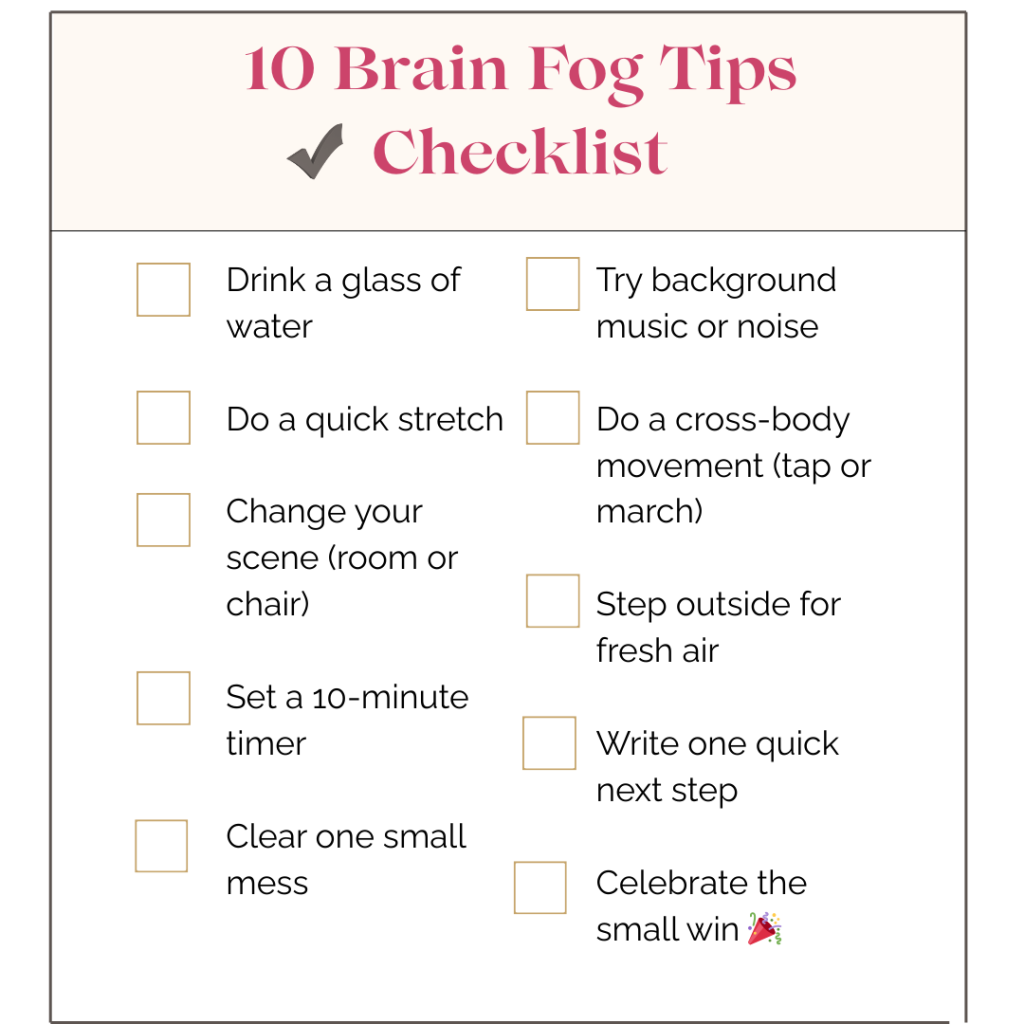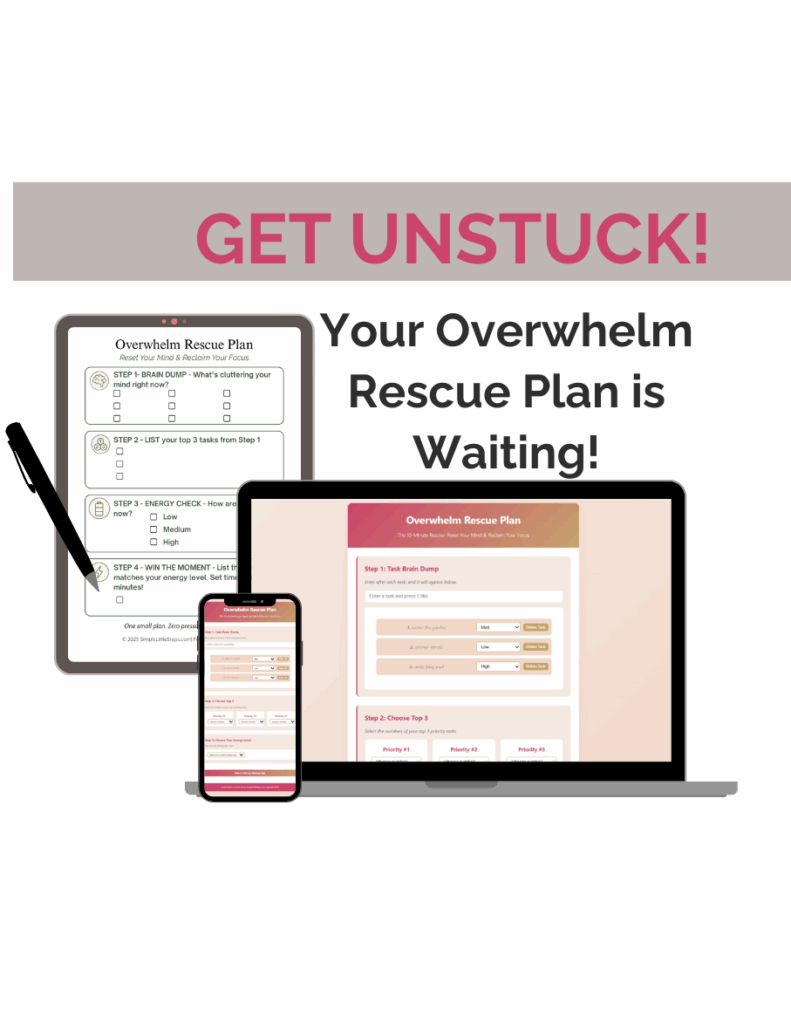10 Brain Fog Tips That Actually Help You Focus
What Is Brain Fog (and Why It Slows You Down)
If you’ve ever stared at your screen unable to think straight, you know what brain fog feels like. It isn’t laziness—it’s a real slowdown in focus and memory. These tips help you work with your personal energy and clear the fog one step at a time.
I’ve had enough of those days to fill a decade, so over time, I started collecting little tricks, quick ways to shake off the brain fog and unstick my thinking. None of these are meant to fix everything or turn me into Superwoman. But they give me a toe-hold, a micro-win, or a splash of momentum that gets me moving again.
These are short, simple, and tested by real life: not only do I use all 10 of these, but all of my now-adult kids have tried, and some routinely fall back on these methods when they need to wake up their brains.
Why These Work for Me
I’m someone who tends to freeze up when I feel overwhelmed, scattered, or low on energy. My focus has hit the road, and my ability to thoughtfully choose the next action is out the window. Sounds like an executive functioning issue, am I right? That’s what happens when we become too overwhelmed, stressed, burned out, or suffer fatigue and brain fog related to short-term or chronic illness.
Especially now, with my cancer treatments, that brain fog period seems to occur daily. I’ve learned some terrific ways to work around this, including these 10 tricks as well as other motivation boosters.
Since then, I’ve learned that tiny physical actions, clear visual cues, or engaging one sense at a time often unlock the door. I’m not trying to overhaul my life in 5 minutes, I’m just flipping on the lights.
10 Brain Fog Tips for Better Focus
While I turn to all 10 of these tricks, this first set is my go-to for clearing some of that fogginess. The brain fog doesn’t go away for good, but my top 5s can give me a good 30-40 minutes of focus time before I need to try another.
1. Say What You’re Doing Out Loud
- “Okay, I’m opening my laptop. Now I’m clicking open my email.” Like a broken record, those looping thoughts that keep you stuck are interrupted, thus bringing you back into your body. Hearing your voice creates a gentle structure and helps transition from mental fog to focused action.
2. Ground Yourself
- Step outside, bare feet in the grass, for a few minutes. No special breathing or mindfulness. Hence, fresh air, nature, and physical contact with the earth (grounding) reset sensory overload, giving your brain a “here and now” signal.
3. Start with a “Micro-Task”
- Pick a task so small it feels ridiculous, such as opening the app, placing the paper on the table, or writing just one word. When your brain is stuck, starting is the hardest part. Micro-tasks remove pressure and trick your brain into being more productive.
4. Clear a Little Visual Clutter
- Set a timer and tidy only what you can in five minutes. Stack papers. Toss trash. Push things aside. Visual noise can be paralyzing. And so, a brief decluttering session creates a sense of order and progress, without requiring you to complete anything.
5. Try a Cross-Body Reset
- Stretch your right arm across your body to the left. Then touch your right hand to your left toes. Repeat on the other side. I learned during an autism therapy session that these movements activate both sides of your brain and regulate your sensory system. It’s surprisingly a great option when full workouts are too much.
6. Do a 5-Minute Stretching Video
- YouTube is full of gentle stretching or “wake-up body” routines. Keep one bookmarked so it’s ready when you are. One of my favorites is Yes2Next, a mom-daughter team-up to show easy and moderate routines. Stretching gets blood flowing and floods your brain with oxygen, both of which are crucial when your thinking feels foggy.
7. Turn on a Timer, and Do Nothing
- First, set a 5-minute timer and sit. No phone, no distractions, no plans. Then, sit and breathe to give your brain a chance to stop fighting. This permission to pause can be the very thing that clears the path forward. Often, motivation appears right before the timer ends.
8. Change Your Scenery, Even Just a Little
- Step outside for 60 seconds. Sit in a different chair. Face the window. Lie on the floor. Because your brain associates locations with behaviors, even a tiny change can reset the mental script and make the next step feel fresh, not forced.
9. Put on Background Noise
- Try instrumental music, coffee shop sounds, or ambient focus playlists for a more relaxing experience. Your brain needs a rhythm to follow, not silence, not lyrics. Ambient noise reduces mental clutter and creates a low-pressure background for focus.
10. Say “Just for Five Minutes…”
- Don’t commit to completing a task; commit to starting it, even if just for five minutes. Five minutes is short enough to bypass resistance, but long enough to build momentum. Once you begin, you may find the fog lifting on its own.
Quick Wins for Low-Energy Days
What helps brain fog fast?
Start with one quick reset: drink water, take a 2-minute movement break, then do a LOW-energy task for 10–25 minutes and stop. One small win clears more fog than pushing through.
What causes brain fog?
Fatigue, stress, illness, and overwork can all slow focus and memory.
Is brain fog the same as laziness?
No. Brain fog is a temporary cognitive slowdown caused by low energy or fatigue. Laziness is a choice not to act.
Can brain fog improve?
Yes. It often improves with rest, hydration, energy tracking, and simplifying tasks to match your current energy level.
When should I see a professional for brain fog?
If brain fog is new, worsening, or persistent, or if it interferes with safety or daily functioning, talk to a healthcare provider.
Save This Checklist!

Final Encouraging Thoughts
Because your brain feels stalled, it doesn’t mean you’re lazy, undisciplined, or failing. It means you’re a human being whose systems are a little overloaded. Every single one of us hits the mental pause button sometimes. The trick is figuring out what helps you press play again.
These little tricks for brain fog aren’t magic, but they’ve saved me from giving up on many days when I had no energy or clarity to spare. They’re bite-sized, doable, and don’t require you to “feel motivated” first, which is the real secret.
Want more support? Try my Overwhelm Rescue Plan or grab the free Energy Tracker Printable to track patterns and find your best windows.
Your Next Step: The Overwhelm Rescue Plan (10-Minute Reset)

When your brain feels crowded and you’re tired of pushing, the Overwhelm Rescue Plan guides you through a quick reset that turns fog into forward motion. It’s designed for transformation—from scattered to steady, from foggy to focused—so you can return to clarity and calm living fast.
- A guided, fill-in form with blank spaces to capture your answers to four key prompts
- A compassionate mini-process that lowers cognitive load and sparks momentum
- You’ll receive: a printable/annotatable PDF (perfect for paper or tablet) plus access to an interactive web page that makes the reset feel twice as easy
Because you don’t need more willpower—you need a 10-minute path back to yourself.

